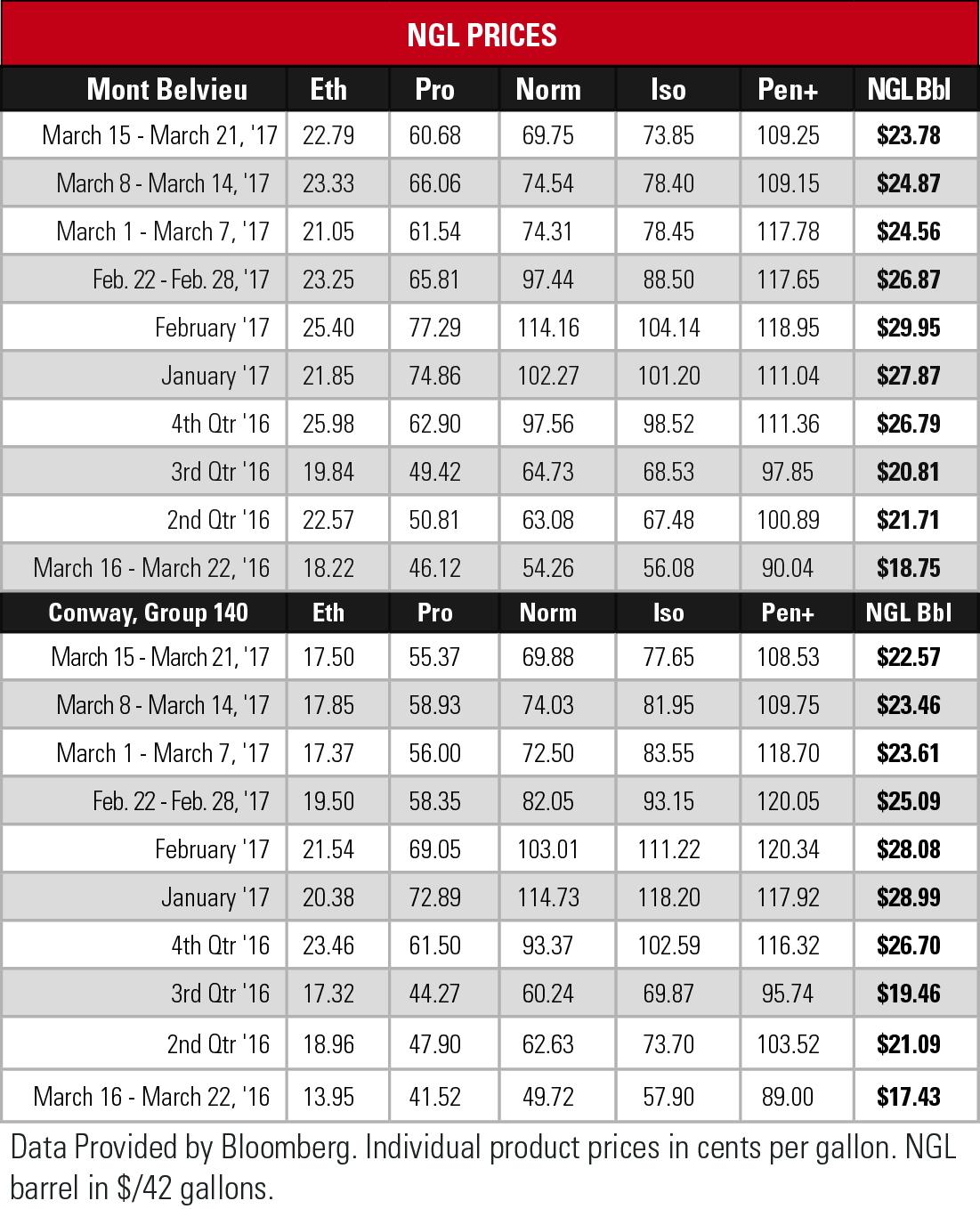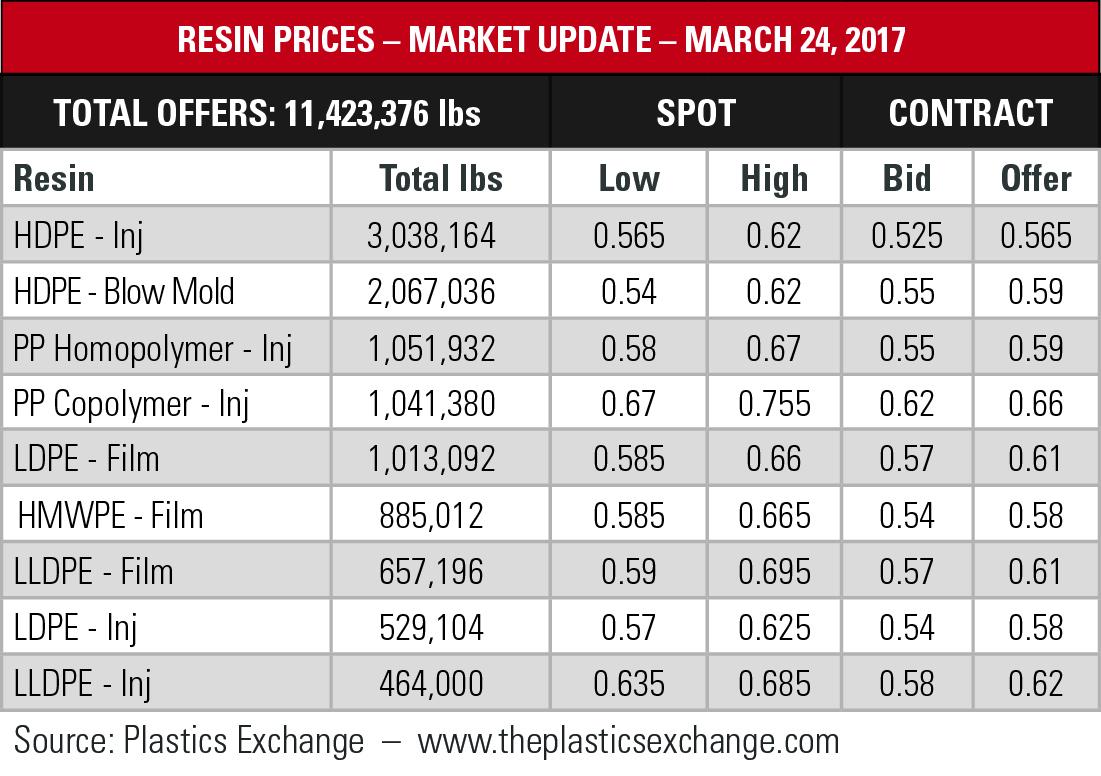
 The butanes returned to their levels of six months ago and the hypothetical NGL barrel fell back to November’s range at both the Mont Belvieu, Texas, and Conway, Kan., hubs last week.
The butanes returned to their levels of six months ago and the hypothetical NGL barrel fell back to November’s range at both the Mont Belvieu, Texas, and Conway, Kan., hubs last week.
The barrel retreated by 4% at both hubs as all components took price hits except for Mont Belvieu C5. Mont Belvieu propane dropped 8% to its lowest level in almost four months.
West Texas Intermediate crude oil has continued to languish in the $40s as U.S. crude inventories, typically up by 30 million barrels (MMbbl) to 35 MMbbl this time of year, have increased by 48 MMbbl since Jan. 1.
“Traders got way ahead of the fundamentals,” En*Vantage analysts said in their recent report, surmising that speculator optimism over OPEC’s adherence to its production cut agreement would eventually balance the market.
“The problem for the market is that speculators are an impatient group,” En*Vantage said. Headwinds are delaying the rebalance. They include:
- High U.S. inventories;
- Rising U.S. rig counts; and
- Fed interest rate hikes.
The gloom does not extend to the long-term outlook for natural gas.
Producers in the Marcellus and Utica shale plays, surveyed by Morningstar Commodities Research, projected an average 11% increase in production for the rest of 2017 compared to 2016 and are planning to ramp up volumes by 18% in 2018. Northeast producers are  anticipating increased takeaway capacity from pipeline expansions and continued effort toward efficiencies.
anticipating increased takeaway capacity from pipeline expansions and continued effort toward efficiencies.
Ethane dipped 2% at Mont Belvieu and barely moved at Conway. However, WTI’s price troubles have given propane and the butanes—which have fallen 29% and 45%, respectively, since early February at Mont Belvieu—price advantages as ethylene feedstocks.
Storage of natural gas in the Lower 48 declined by 150 billion cubic feet (Bcf) in the week ended March 17, the Energy Information Administration reported. The decrease, close to the Bloomberg consensus of 152 Bcf, resulted in a total of 2.092 Tcf. The figure is 16% less than the 2.491 Tcf figure at the same time in 2016 and 14.6% above the five-year average of 1.826 Tcf.
Joseph Markman can be reached at jmarkman@hartenergy.com and @JHMarkman.

Recommended Reading
Blackstone Buys NatGas Plant in ‘Data Center Valley’ for $1B
2025-01-24 - Ares Management’s Potomac Energy Center, sited in Virginia near more than 130 data centers, is expected to see “significant further growth,” Blackstone Energy Transition Partners said.
Cummins, Liberty Energy to Deploy New Engine for Fracking Platform This Year
2025-01-29 - Liberty Energy Inc. and Cummins Inc. are deploying the natural gas large displacement engine developed in a partnership formed in 2024.
SM Energy Marries Wildcatting and Analytics in the Oil Patch
2025-04-01 - As E&P SM Energy explores in Texas and Utah, Herb Vogel’s approach is far from a Hail Mary.
E&P Highlights: Feb. 3, 2025
2025-02-03 - Here’s a roundup of the latest E&P headlines, from a forecast of rising global land rig activity to new contracts.
Watch for Falling Gas DUCs: E&Ps Resume Completions at $4 Gas
2025-01-23 - Drilled but uncompleted (DUC) gas wells that totaled some 500 into September 2024 have declined to just under 400, according to a J.P. Morgan Securities analysis of Enverus data.
Comments
Add new comment
This conversation is moderated according to Hart Energy community rules. Please read the rules before joining the discussion. If you’re experiencing any technical problems, please contact our customer care team.






